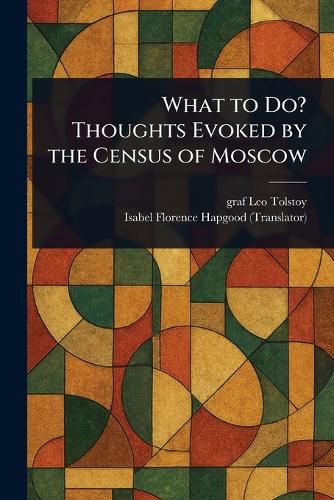Readings Newsletter
Become a Readings Member to make your shopping experience even easier.
Sign in or sign up for free!
You’re not far away from qualifying for FREE standard shipping within Australia
You’ve qualified for FREE standard shipping within Australia
The cart is loading…






This title is printed to order. This book may have been self-published. If so, we cannot guarantee the quality of the content. In the main most books will have gone through the editing process however some may not. We therefore suggest that you be aware of this before ordering this book. If in doubt check either the author or publisher’s details as we are unable to accept any returns unless they are faulty. Please contact us if you have any questions.
"What To Do?" by Leo Tolstoy is a powerful exploration of social justice and inequality in 19th-century Moscow. Inspired by his experiences with the Moscow census, Tolstoy delves into the realities of poverty and the stark social conditions facing the city's most vulnerable populations.
A profound work of social reform, "What To Do?" offers Tolstoy's reflections on how individuals can respond to the suffering around them. His insights into poverty and societal structures remain relevant, prompting critical examination of inequality and individual responsibility. Tolstoy's observations and philosophical approach continue to inspire discussions on social action and the pursuit of a more just world. This meticulously prepared print edition allows readers to engage directly with Tolstoy's timeless appeal for social change.
This work has been selected by scholars as being culturally important, and is part of the knowledge base of civilization as we know it.
This work is in the public domain in the United States of America, and possibly other nations. Within the United States, you may freely copy and distribute this work, as no entity (individual or corporate) has a copyright on the body of the work.
Scholars believe, and we concur, that this work is important enough to be preserved, reproduced, and made generally available to the public. We appreciate your support of the preservation process, and thank you for being an important part of keeping this knowledge alive and relevant.
$9.00 standard shipping within Australia
FREE standard shipping within Australia for orders over $100.00
Express & International shipping calculated at checkout
This title is printed to order. This book may have been self-published. If so, we cannot guarantee the quality of the content. In the main most books will have gone through the editing process however some may not. We therefore suggest that you be aware of this before ordering this book. If in doubt check either the author or publisher’s details as we are unable to accept any returns unless they are faulty. Please contact us if you have any questions.
"What To Do?" by Leo Tolstoy is a powerful exploration of social justice and inequality in 19th-century Moscow. Inspired by his experiences with the Moscow census, Tolstoy delves into the realities of poverty and the stark social conditions facing the city's most vulnerable populations.
A profound work of social reform, "What To Do?" offers Tolstoy's reflections on how individuals can respond to the suffering around them. His insights into poverty and societal structures remain relevant, prompting critical examination of inequality and individual responsibility. Tolstoy's observations and philosophical approach continue to inspire discussions on social action and the pursuit of a more just world. This meticulously prepared print edition allows readers to engage directly with Tolstoy's timeless appeal for social change.
This work has been selected by scholars as being culturally important, and is part of the knowledge base of civilization as we know it.
This work is in the public domain in the United States of America, and possibly other nations. Within the United States, you may freely copy and distribute this work, as no entity (individual or corporate) has a copyright on the body of the work.
Scholars believe, and we concur, that this work is important enough to be preserved, reproduced, and made generally available to the public. We appreciate your support of the preservation process, and thank you for being an important part of keeping this knowledge alive and relevant.